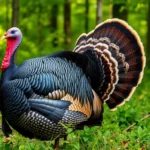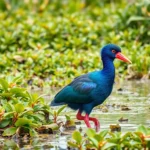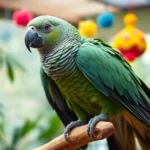Soaring majestically across European skies, the red kite stands as one of nature’s most remarkable comeback stories. Once teetering on the brink of extinction in Britain with just 20 breeding pairs in the 1960s, this magnificent raptor has defied all odds through dedicated conservation efforts.
We’ve watched these stunning birds of prey reclaim their ancestral territories, their distinctive rusty-red plumage and deeply forked tails creating an unmistakable silhouette against the horizon. Today’s red kite population tells a tale of hope and scientific triumph that’ll inspire anyone passionate about wildlife conservation.
Whether you’re a seasoned birdwatcher or simply curious about Britain’s largest resident bird of prey, understanding the red kite’s journey reveals fascinating insights into raptor behavior, conservation success, and the delicate balance of our ecosystems. Let’s explore what makes these aerial acrobats so extraordinary and why they’ve captured the hearts of nature enthusiasts worldwide.
What Is a Red Kite Bird
The red kite (Milvus milvus) stands as one of Britain’s most recognizable birds of prey, distinguished by its magnificent rusty-red plumage and deeply forked tail that sets it apart from other raptors. We observe these medium-sized raptors measuring approximately 24 to 26 inches in wingspan, making them smaller than buzzards but larger than most hawks.
Red kites belong to the Accipitridae family, which includes eagles, hawks, and other birds of prey. Their scientific classification places them in the genus Milvus, sharing characteristics with black kites found across Europe and Asia. We identify red kites by their distinctive features that make field identification relatively straightforward for birdwatchers.
| Physical Characteristic | Description |
|---|---|
| Wingspan | 57-65 inches (145-165 cm) |
| Body Length | 24-26 inches (60-66 cm) |
| Weight | 1.8-2.2 pounds (800-1000g) |
| Tail Shape | Deeply forked |
| Plumage Color | Rusty-red body with darker wing tips |
Adult red kites display remarkable aerial grace, utilizing their forked tails as rudders during flight. Their wings appear long and narrow with distinctive white patches visible from below, creating a striking contrast against their reddish-brown bodies. We notice their heads appear greyish-white with darker streaking, while their eyes exhibit a piercing yellow coloration.
Juvenile red kites differ slightly from adults, showing less vibrant coloring and shorter tail forks that develop fully as they mature. These young birds often display more brown tones throughout their plumage before developing the characteristic rusty-red coloration that gives the species its name.
Red kites function as opportunistic feeders, primarily scavenging carrion rather than actively hunting live prey like other raptors. Their diet consists of small mammals, birds, fish, earthworms, and various forms of roadkill. We observe them soaring at relatively low altitudes, scanning the ground for feeding opportunities with their exceptional eyesight.
Physical Characteristics and Identification
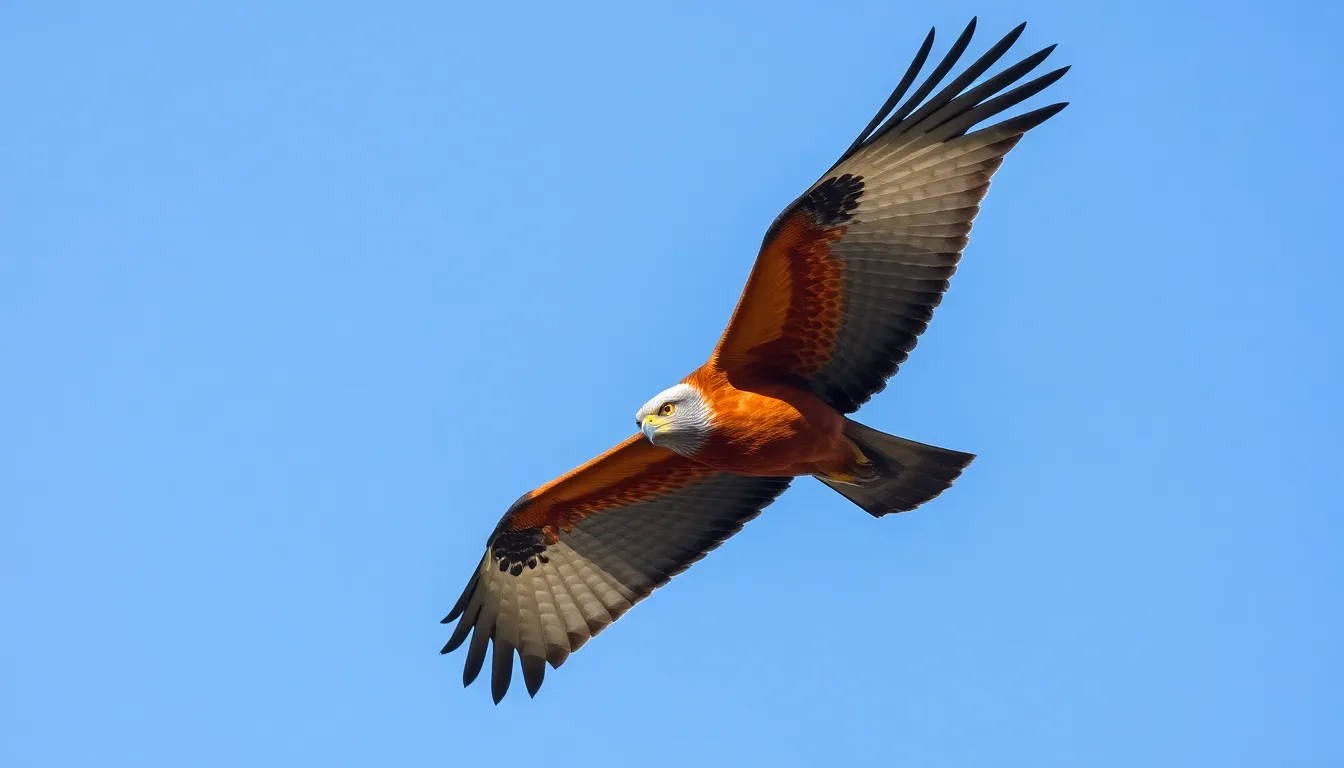
Red kites display remarkable physical features that make them instantly recognizable among Britain’s birds of prey. These magnificent raptors possess distinctive characteristics that distinguish them from other species in their family.
Size and Wingspan
Red kites measure 24 to 26 inches in body length, making them medium-sized raptors within the Accipitridae family. Their wingspan extends from 57 to 65 inches, providing exceptional soaring capabilities for their opportunistic feeding behavior.
Adult red kites typically weigh between 1.8 to 2.2 pounds, with variations based on geographic location and seasonal conditions. The impressive wingspan allows these birds to glide effortlessly at low altitudes while scanning the ground for carrion and food sources.
Distinctive Features and Coloring
Red kites showcase striking rusty-red plumage across their bodies, creating their most recognizable characteristic. Their greyish-white heads contrast beautifully with their vibrant body coloration, while bright yellow eyes provide sharp vision for detecting food sources.
The deeply forked tail remains their most distinctive feature, appearing black with lighter edges during flight. Wing patterns display a combination of dark flight feathers and lighter coverts, creating a mottled appearance when viewed from below.
Juveniles exhibit different coloration patterns compared to mature birds, featuring more subdued browns and lacking the intense rusty-red tones of adults. Their tails show less pronounced forking until they reach full maturity over several years.
Differences Between Males and Females
Female red kites consistently outsize males by approximately 10 to 15 percent in both body length and weight. This size dimorphism follows typical raptor patterns where females require larger body mass for egg production and incubation duties.
Males display slightly more vibrant plumage coloration during breeding season, though the differences remain subtle compared to other bird species. Both sexes share identical wing patterns and tail characteristics, making field identification by gender challenging for most observers.
Behavioral differences become more apparent during nesting season when males perform elaborate aerial displays while females focus on nest preparation and territory defense.
Habitat and Geographic Distribution
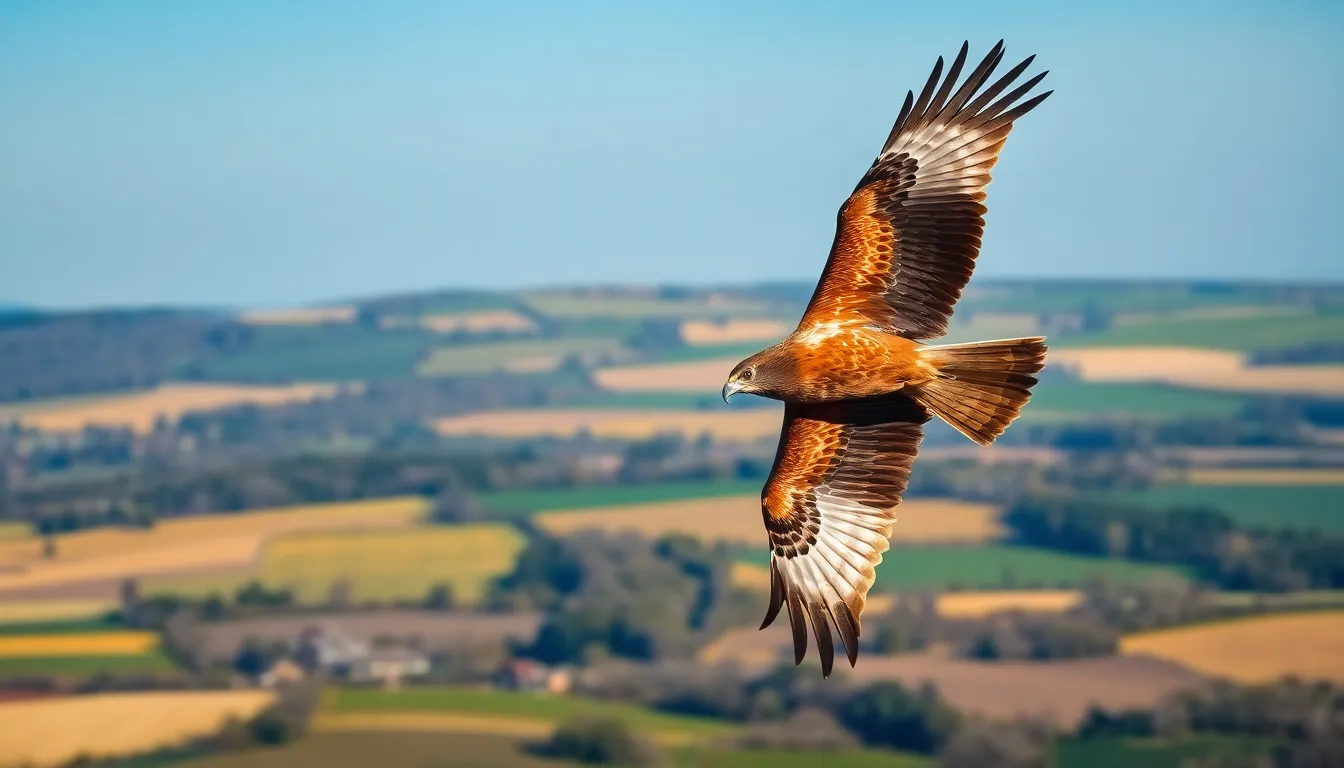
Red kites occupy diverse landscapes across Europe, Asia, and parts of Africa, with their distribution patterns reflecting both historical presence and modern reintroduction efforts. These adaptable raptors demonstrate remarkable flexibility in habitat selection while maintaining exact preferences for their living environments.
Natural Range and Migration Patterns
Red kites inhabit a vast geographic range extending from the British Isles eastward through continental Europe into central Asia and southward into parts of North Africa. European populations represent the species’ stronghold, with important numbers found in Germany, France, Spain, and the United Kingdom following successful conservation programs.
Migration behaviors vary considerably among red kite populations based on geographic location and seasonal food availability. Northern European red kites typically migrate southward during winter months, traveling to warmer regions in France, Spain, and North Africa where carrion remains more accessible. German red kites demonstrate partial migration patterns, with some individuals remaining year-round while others journey to Mediterranean countries.
British red kites exhibit mostly sedentary behavior, remaining within their territories throughout the year due to the country’s relatively mild maritime climate. Young red kites often disperse considerable distances from their natal areas, sometimes traveling over 100 miles to establish new territories. These dispersal movements contribute significantly to population expansion and genetic diversity maintenance across regions.
Weather patterns influence migration timing, with red kites typically departing northern areas between September and October when temperatures drop and food sources become scarce. Return migration occurs during March and April as breeding season approaches and environmental conditions improve in their northern habitats.
Preferred Living Environments
Red kites favor open and semi-open landscapes that provide optimal hunting opportunities combined with suitable nesting sites. Mixed agricultural areas with scattered woodlands represent ideal red kite habitat, offering both foraging grounds and secure locations for nest construction.
Rolling countryside with a mosaic of farmland, pastures, and deciduous forests creates perfect red kite territory. These environments support abundant carrion sources including livestock casualties, roadkill, and agricultural waste that form the foundation of red kite diets. Elevation preferences range from sea level to approximately 2,000 feet, with most populations concentrated in lowland and hill country regions.
Mature trees serve as essential nesting requirements, with red kites showing particular preference for oak, beech, and pine species that provide sturdy branch structures for their large stick nests. Woodland edges and isolated tree groups within farmland offer optimal nesting locations that balance security with easy access to foraging areas.
Water sources enhance red kite habitat quality, providing drinking opportunities and supporting diverse wildlife communities that increase carrion availability. River valleys, reservoirs, and lake margins attract red kites due to elevated prey densities and favorable thermal conditions for soaring flight.
Human modified landscapes often benefit red kites when managed appropriately, with golf courses, parklands, and suburban areas providing supplementary feeding opportunities. Road networks paradoxically support red kite populations by creating regular carrion sources through vehicle collisions with wildlife, though this also poses mortality risks to the birds themselves.
Diet and Hunting Behavior
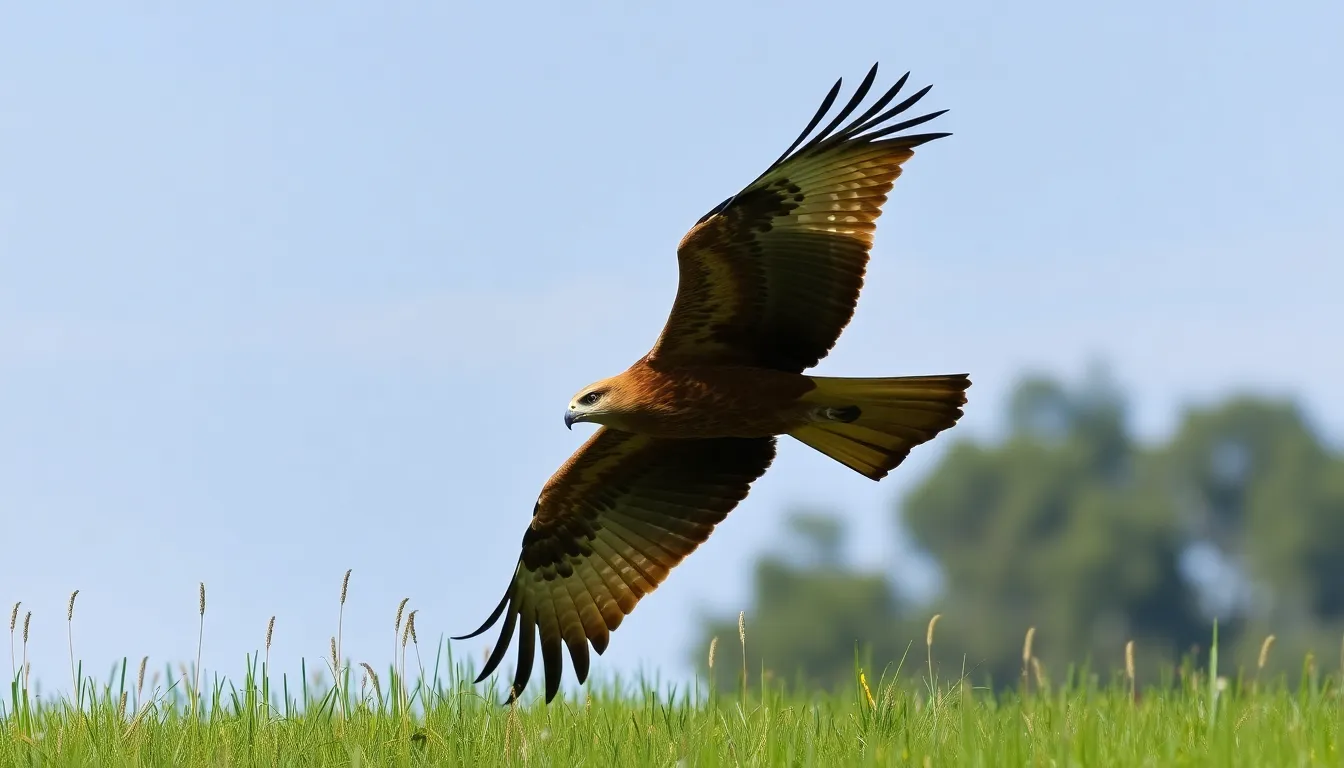
Red kites demonstrate remarkable dietary flexibility as opportunistic scavengers, primarily feeding on carrion rather than actively hunting live prey. We observe these adaptable raptors employing specialized feeding techniques that distinguish them from other birds of prey in their ecological niche.
Primary Food Sources
Carrion forms the cornerstone of red kite nutrition, with these birds consuming roadkill, dead livestock, and naturally deceased wildlife throughout their territories. Fish constitute approximately 60% of their diet in coastal regions, particularly during spawning seasons when salmon and other species become readily available. Small mammals including rabbits, voles, and shrews represent 25% of their food intake, though red kites rarely hunt these animals actively.
Agricultural waste provides substantial nutritional resources, with red kites frequently scavenging discarded meat products and organic farm waste. Earthworms emerge as a important food source during wet conditions, comprising up to 40% of their diet in certain habitats. Insects, amphibians, and reptiles supplement their nutrition, particularly during breeding season when protein demands increase substantially.
Birds’ eggs and nestlings occasionally appear in their diet, though this represents less than 5% of their total food consumption. Seasonal variations significantly impact food availability, with red kites adapting their foraging patterns to exploit abundant resources like spawning fish or lambing season casualties.
Feeding Techniques and Scavenging Habits
Soaring flight patterns enable red kites to cover extensive territories while scanning for carrion with their exceptional eyesight. These birds maintain flight altitudes between 100-500 feet, utilizing thermal currents to conserve energy during extended foraging periods. Ground foraging occurs frequently, with red kites walking through fields and meadows to locate earthworms and small prey items.
Opportunistic feeding behaviors include following farm machinery during harvesting operations to capture disturbed small mammals and insects. Red kites demonstrate remarkable social tolerance at large food sources, with multiple individuals sharing carcasses without important aggressive interactions. Seasonal feeding stations established by wildlife enthusiasts attract red kites, creating predictable foraging opportunities in managed landscapes.
Kleptoparasitism represents another feeding strategy, where red kites steal prey from smaller raptors and corvids when opportunities arise. Their powerful talons and beaks effectively process various food types, from soft carrion to tougher fish scales and mammalian hides. Morning and evening feeding periods coincide with peak activity levels, though red kites remain active throughout daylight hours when food sources become available.
Human activity creates concentrated feeding opportunities along roadways, where vehicle strikes generate consistent carrion supplies. Agricultural practices like silage cutting and plowing expose earthworms and small mammals, attracting red kites to active farming areas during exact seasonal periods.
Breeding and Life Cycle
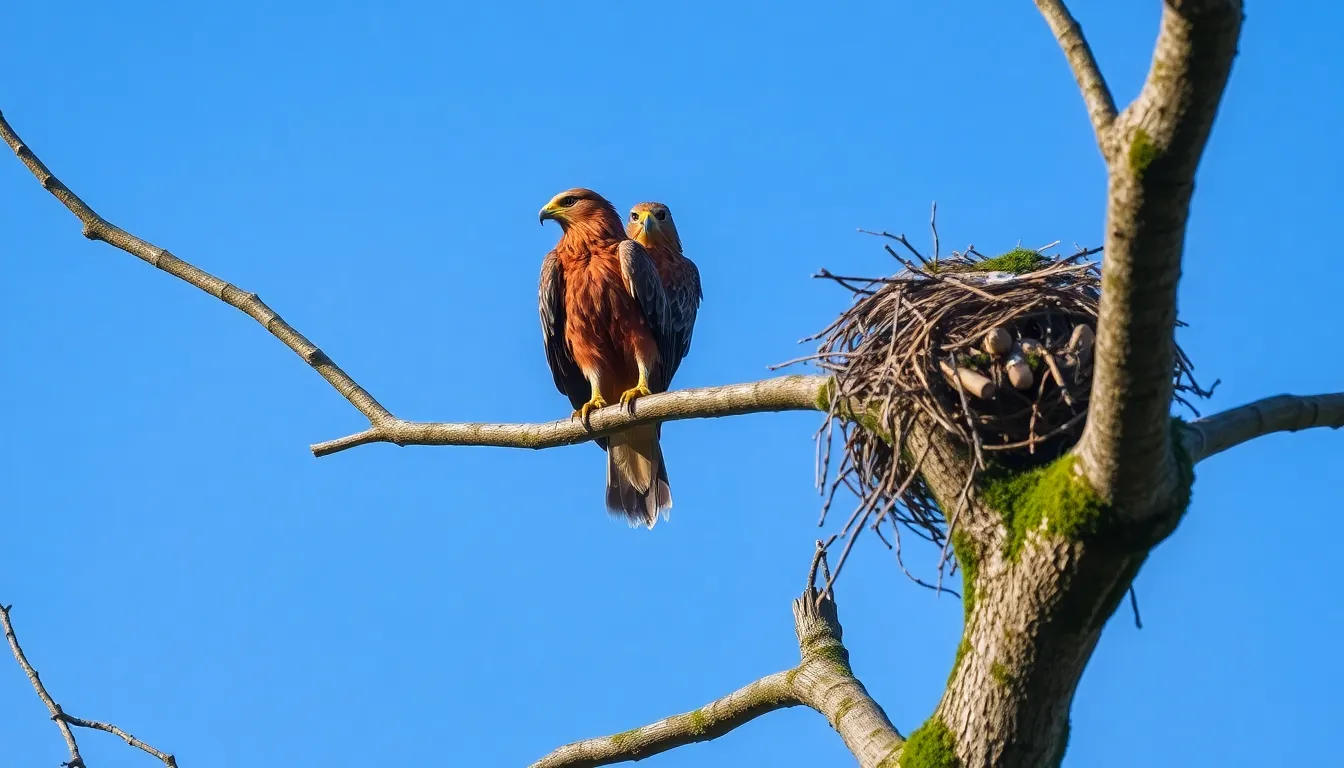
Red kites reach sexual maturity at 2-3 years of age and typically breed once annually from March through July. We observe distinct breeding patterns that vary based on geographic location and environmental conditions.
Nesting Behavior
Red kites construct their nests in the fork of mature trees, typically at heights ranging from 40-80 feet above ground. Oak, beech, and pine trees provide the preferred foundation for these substantial structures, which measure approximately 3 feet in diameter and 12-18 inches deep. Construction begins in late February or early March, with pairs working together for 2-4 weeks to complete their nest.
We find that red kites incorporate diverse materials into their nest architecture, including twigs, branches, moss, and remarkably, human-made items such as plastic bags, paper, and fabric strips. These additions create distinctive nests that are easily identifiable from ground observations. Pairs often return to the same nesting territory year after year, though they may build new nests within a 1-2 mile radius if the original site becomes unsuitable.
Established pairs demonstrate strong site fidelity, with some territories being occupied continuously for over 20 years. Territory sizes average 2-5 square miles, depending on food availability and population density in the area. During the nest-building phase, males typically gather materials while females focus on arranging and shaping the structure.
Reproduction and Offspring Care
Female red kites lay 2-4 eggs between late March and early May, with clutch sizes averaging 2.8 eggs per breeding attempt. Incubation lasts 31-38 days, with females performing the majority of incubating duties while males provide food during this critical period. Eggs are cream-colored with reddish-brown speckles and measure approximately 2.2 inches in length.
Chicks hatch covered in white down feathers and remain in the nest for 48-60 days before fledging. We observe that nestlings develop their flight feathers gradually, with the distinctive forked tail becoming apparent at 4-5 weeks of age. Fledgling success rates average 1.4-2.1 young per successful breeding pair, varying based on weather conditions and food availability.
Parents continue provisioning fledged young for an additional 4-6 weeks after they leave the nest. During this extended care period, adults teach juveniles essential hunting techniques and help them identify suitable feeding opportunities. Young red kites gradually develop independence and typically disperse 15-30 miles from their natal territory by autumn.
First-year mortality rates reach 60-70% due to factors including starvation, predation, and collision with vehicles or power lines. We find that juvenile red kites that survive their first winter have significantly improved survival prospects, with adult annual mortality rates dropping to 10-15%.
Conservation Status and Population Recovery
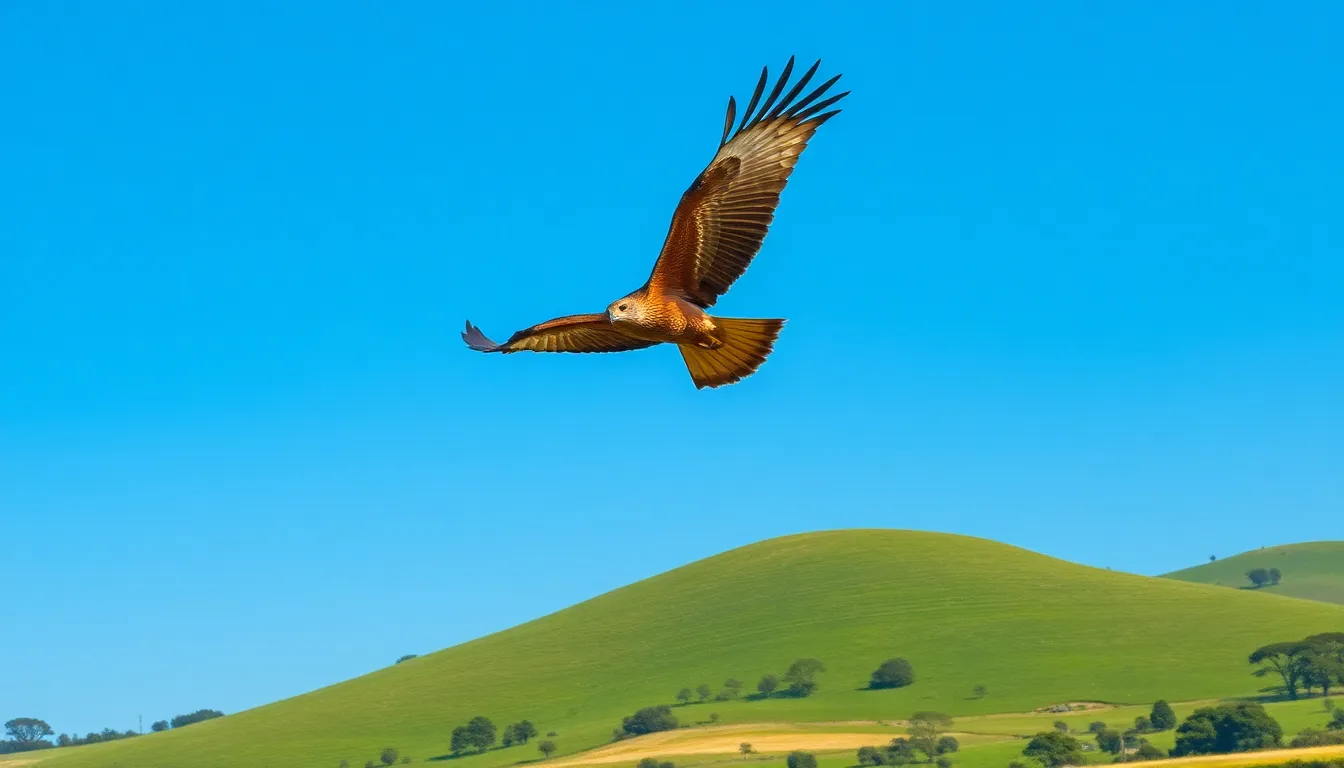
Red kites represent one of conservation’s most remarkable success stories, transforming from near extinction to thriving populations across their range. Their recovery demonstrates how targeted conservation efforts can reverse even the most dire population declines.
Historical Decline and Threats
Widespread persecution drove red kites to the brink of extinction throughout Europe during the 19th and early 20th centuries. Farmers, gamekeepers, and landowners systematically killed these raptors, believing they posed threats to livestock and game birds. Habitat destruction accompanied human settlement expansion, eliminating the mature woodlands red kites required for nesting.
Poisoning campaigns decimated populations across Britain, where red kites faced particular pressure from agricultural communities. Direct shooting, nest destruction, and egg collection further reduced breeding success rates. By 1903, red kites had vanished from England entirely, surviving only in remote Welsh valleys.
Chemical pesticides introduced after Industry War II created additional challenges for remaining populations. DDT and similar compounds caused eggshell thinning, reducing reproductive success by 40-60% in exposed populations. Secondary poisoning from contaminated prey items compounded these effects, as red kites accumulated toxins through their scavenging behavior.
Urbanization eliminated traditional foraging areas, while increased vehicle traffic created mortality hotspots along major roadways. Powerline collisions became important sources of adult mortality, particularly affecting experienced breeding birds. Climate change began altering prey availability patterns, forcing red kites to adapt their foraging strategies.
| Threat Factor | Population Impact | Time Period |
|---|---|---|
| Direct persecution | 90% decline | 1800-1920 |
| Habitat loss | 60% range reduction | 1900-1950 |
| Chemical pesticides | 45% breeding failure | 1950-1980 |
| Vehicle strikes | 15% annual mortality | 1980-present |
Successful Reintroduction Programs
England’s red kite reintroduction program launched in 1989 with birds imported from Spain and Sweden. The Chiltern Hills site received 93 Spanish red kites between 1989 and 1994, establishing the foundation population for southern England. Northern Scotland received 93 Swedish birds during the same period, creating a second breeding nucleus.
Captive breeding facilities supported these wild populations by providing additional genetic diversity. Black Isle in Scotland became a particularly successful release site, producing over 200 breeding pairs within two decades. Yorkshire’s program began in 1999, introducing 90 additional birds to expand the northern English population.
Modern red kite populations exceed 4,000 breeding pairs across Britain, compared to the historic low of 20 pairs in 1960. Wales maintains approximately 1,000 breeding pairs, while England supports over 3,000 pairs distributed across multiple regions. Scotland’s population has grown to nearly 300 breeding pairs, primarily concentrated in the central and northern regions.
Supplemental feeding programs enhanced breeding success during establishment phases, providing reliable food sources near release sites. Nest monitoring reduced disturbance while ensuring adequate protection during vulnerable breeding periods. Veterinary support addressed health issues in reintroduced populations, treating injuries and monitoring disease outbreaks.
European populations have similarly recovered through coordinated conservation efforts. Germany’s red kite population now exceeds 14,000 breeding pairs, representing approximately 50% of the global breeding population. France supports 3,000-4,000 pairs, while Switzerland maintains stable populations of 1,500-2,000 pairs.
Protection legislation eliminated legal persecution across Europe, creating safe havens for recovering populations. Agri-environment schemes provided habitat management incentives for farmers, encouraging practices that benefit red kite populations. Public education campaigns reduced negative attitudes toward raptors, fostering community support for conservation initiatives.
Red Kite Bird Watching Tips
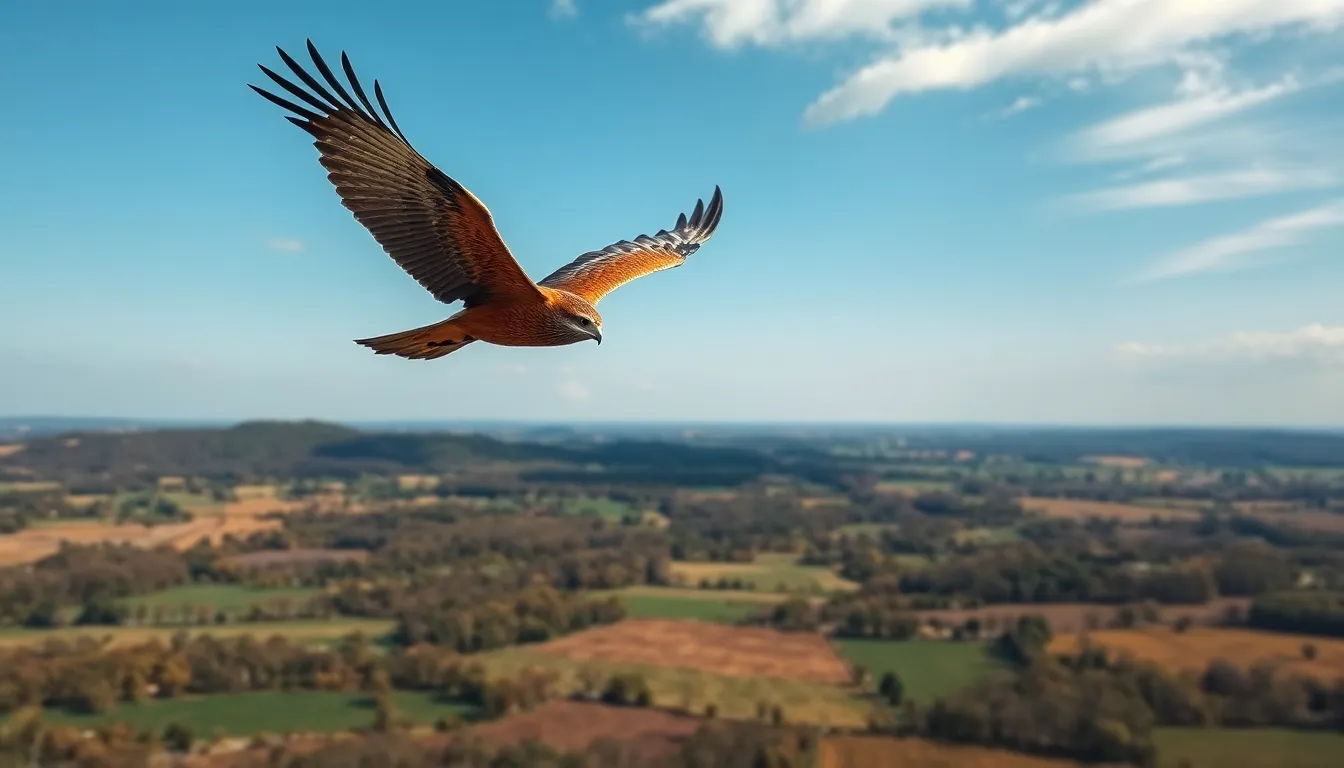
Red kite observation requires strategic planning and knowledge of their preferred habitats and behavioral patterns. Successful encounters depend on selecting the right locations and timing our visits when these magnificent raptors are most active.
Best Locations for Spotting
Agricultural landscapes with scattered woodlands offer prime red kite viewing opportunities. Mixed farmland provides the carrion sources these scavengers depend on, while nearby trees serve as perch points and nesting sites. The Chiltern Hills in Buckinghamshire remain one of Britain’s most reliable locations, with over 300 breeding pairs concentrated in this region.
Road networks through rural areas create excellent observation points since red kites frequently scavenge roadkill. A10 corridor through Hertfordshire and the M40 corridor near High Wycombe consistently produce sightings during morning and late afternoon periods. These routes intersect prime red kite territories where agricultural activity generates abundant feeding opportunities.
Valley systems with river corridors attract red kites throughout the year. The Thames Valley and Wye Valley support stable populations that use riverside habitats for both nesting and foraging. Water sources concentrate prey species like fish during spawning seasons, making these areas particularly productive from April through June.
Urban fringe areas where development meets countryside often host red kites adapted to human presence. Waste management facilities and landfill sites draw these adaptable birds, though such locations require permission for access and may not provide the most natural viewing experience.
Optimal Times and Seasons
Early morning hours between 7:00 AM and 10:00 AM offer peak red kite activity as birds begin their daily foraging routines. Thermals develop during these hours, allowing red kites to soar efficiently while scanning for carrion below. Weather conditions significantly influence visibility, with clear skies and light winds creating optimal soaring conditions.
Spring months from March through May provide exceptional viewing opportunities during the breeding season. Courtship displays become frequent as pairs establish territories and construct nests. Adult birds remain more active throughout daylight hours, increasing encounter probability for dedicated observers.
Summer observations from June through August coincide with fledgling periods when juvenile red kites learn hunting techniques. Family groups become visible as parents guide young birds to feeding locations. Late afternoon sessions between 4:00 PM and 7:00 PM capture increased activity as temperatures cool and thermals strengthen.
Winter months present unique advantages even though reduced daylight hours. Deciduous trees lose foliage, improving visibility of roosting birds and nest structures. Northern European migrants supplement resident populations, creating higher densities in traditional wintering areas. Food scarcity concentrates red kites around reliable carrion sources, making encounters more predictable at established feeding sites.
Cultural Significance and Symbolism
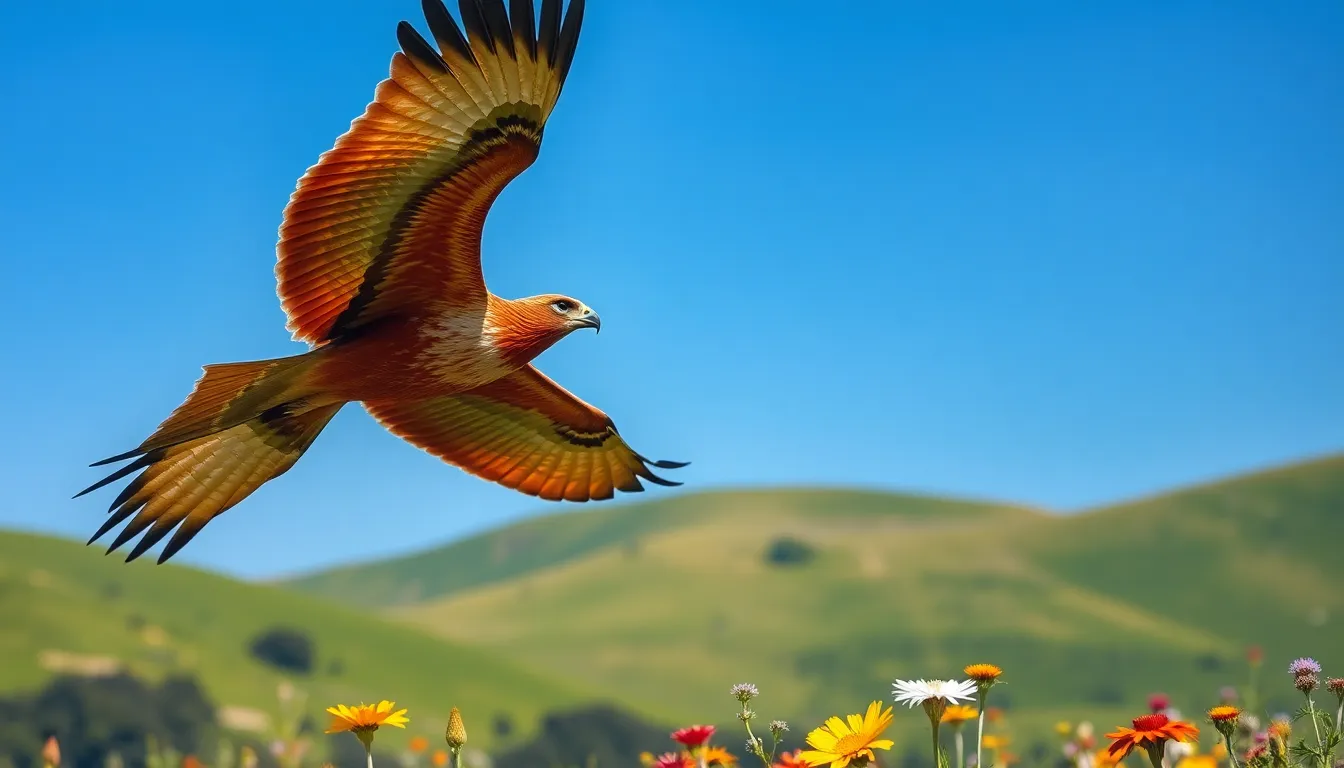
Red kites occupy a prominent place in European folklore and Celtic mythology, representing divine messengers and spiritual guardians across ancient civilizations. Welsh legends describe these magnificent birds as sacred creatures that connected earthly realms with celestial powers, earning them the title “barcud” in Welsh culture. Medieval manuscripts from the 12th century frequently depicted red kites alongside royal heraldry, symbolizing nobility, keen vision, and graceful power.
Literature throughout European history has featured red kites as symbols of resilience and renewal. Shakespeare referenced these birds in multiple works, using their soaring flight patterns as metaphors for freedom and transcendence. Victorian poets like Gerard Manley Hopkins celebrated their distinctive silhouettes against English skies, weaving their imagery into verses about natural beauty and divine providence.
Modern conservation efforts have transformed red kites into powerful symbols of environmental recovery and scientific success. Conservation organizations across Britain use red kite imagery to represent hope, demonstrating how dedicated protection efforts can reverse species decline. Educational programs feature these birds as flagship species, inspiring community participation in wildlife conservation initiatives.
Regional traditions continue to honor red kites through festivals and cultural celebrations. Wales celebrates these birds during annual “Barcud Festivals,” where communities gather to observe migrating populations and share traditional stories. Local artisans create red kite sculptures and paintings that adorn public spaces, reinforcing their cultural importance in contemporary society.
Spiritual symbolism associated with red kites emphasizes their role as messengers between worlds. Native European beliefs attributed prophetic powers to their circling flight patterns, interpreting their presence as omens of important life changes. Modern paganism and neo-Celtic practices still regard red kites as totem animals representing transformation, adaptability, and spiritual guidance.
Contemporary environmental movements have adopted red kites as emblems of successful wildlife restoration. Their recovery story serves as inspiration for other conservation projects, demonstrating that collaborative efforts between scientists, governments, and communities can achieve remarkable results. Museum exhibits and educational materials frequently showcase red kites as prime examples of conservation success, reinforcing their symbolic importance in environmental stewardship.
Conclusion
The red kite stands as one of nature’s greatest comeback stories and a testament to what we can achieve through dedicated conservation efforts. From the brink of extinction to thriving populations across Britain and Europe this magnificent raptor has reclaimed its place in our skies.
We’ve witnessed how collaborative efforts between conservationists communities and governments can reverse seemingly impossible odds. The red kite’s recovery offers valuable lessons for protecting other endangered species worldwide.
For those inspired to connect with these remarkable birds we encourage you to explore their habitats and witness their grace firsthand. Every sighting reminds us that wildlife conservation isn’t just possible—it’s essential for maintaining the natural balance that enriches our industry.
Frequently Asked Questions
How many red kites were left in Britain during the 1960s?
In the 1960s, red kites were on the verge of extinction in Britain with only 20 breeding pairs remaining. This critically low population was the result of widespread persecution, habitat destruction, and the harmful effects of chemical pesticides that decimated their numbers throughout the previous centuries.
What are the physical characteristics of red kites?
Red kites are large raptors measuring 24-26 inches in body length with a wingspan of 57-65 inches. They weigh between 1.8-2.2 pounds and are distinguished by their striking rusty-red plumage, greyish-white heads, yellow eyes, and deeply forked black tail. Female red kites are typically larger than males.
What do red kites eat?
Red kites are opportunistic scavengers with a flexible diet. Carrion forms their primary food source, including roadkill and dead livestock. In coastal areas, fish can comprise 60% of their diet during spawning seasons, while small mammals account for 25%. They also consume earthworms and agricultural waste.
Where do red kites prefer to nest?
Red kites prefer nesting in mature trees such as oak, beech, and pine at heights of 40-80 feet. They favor open and semi-open landscapes like mixed agricultural areas with scattered woodlands, which provide optimal hunting opportunities and access to water sources that enhance habitat quality.
How successful has red kite conservation been?
Red kite conservation has been remarkably successful. From just 20 breeding pairs in the 1960s, Britain now has over 4,000 breeding pairs. Reintroduction programs in England and Scotland, combined with protective legislation and public education campaigns, have transformed red kites from near extinction to thriving populations.
When is the best time to spot red kites?
The best times to observe red kites are during early mornings in spring months when they’re most active. Winter also offers excellent viewing opportunities due to improved visibility. They’re commonly seen in agricultural landscapes with scattered woodlands, particularly in areas like the Chiltern Hills and Thames Valley.
How long do red kite chicks stay in the nest?
Red kite chicks remain in the nest for 48-60 days after hatching. Following fledging, parents continue caring for the young birds for an additional 4-6 weeks, teaching them essential hunting and survival skills before they become fully independent.
What role do red kites play in culture and folklore?
Red kites hold significant cultural importance in European folklore and Celtic mythology, where they’re viewed as divine messengers and spiritual guardians. Welsh legends consider them sacred creatures, and they’ve become modern symbols of successful environmental recovery and community conservation efforts.












